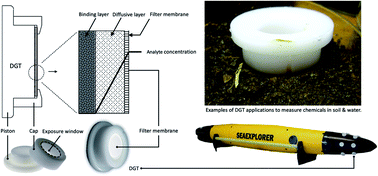当前位置:
X-MOL 学术
›
Anal. Methods
›
论文详情
Our official English website, www.x-mol.net, welcomes your feedback! (Note: you will need to create a separate account there.)
Assessment of ATR-FTIR spectroscopy with multivariate analysis to investigate the binding mechanisms of Ag and TiO2 nanoparticles to Chelex®-100 or Metsorb™ for the DGT technique
Analytical Methods ( IF 3.1 ) Pub Date : 2020/01/09 , DOI: 10.1039/c9ay02458a Hamid Pouran 1, 2, 3 , Rosario Perez Colodrero 1, 2, 3 , Shuang Wu 3, 4, 5, 6 , Gary Hix 1, 2, 3 , Julia Zakharova 1, 2, 3 , Hao Zhang 3, 4, 5, 6
Analytical Methods ( IF 3.1 ) Pub Date : 2020/01/09 , DOI: 10.1039/c9ay02458a Hamid Pouran 1, 2, 3 , Rosario Perez Colodrero 1, 2, 3 , Shuang Wu 3, 4, 5, 6 , Gary Hix 1, 2, 3 , Julia Zakharova 1, 2, 3 , Hao Zhang 3, 4, 5, 6
Affiliation

|
Studying nanomaterials' ecotoxicology is not new but there are still gaps in our understanding of their fate in the environment. A major challenge is lack of reliable tools to measure available concentrations of nanoparticles (NPs) in soil and water. Diffusive gradients in thin-films (DGT) is a robust technique for measuring the concentrations of trace metals in the environment. We have also shown that it could be potentially developed for measuring ZnO NPs. To further investigate the suitability of DGT for measuring the available concentrations of NPs in soil and water we selected two model nanoparticles, Ag and TiO2, which are widely used and incorporated in different commercial products. We aimed to understand (1) if two of the DGT binding agents, Chelex®-100 and Metsorb™, could irreversibly retain our model NPs and if yes (2) what might be the differences between bound Ag and TiO2 NPs and Ag+ and Ti4+ cations. We used ATR-FTIR spectroscopy for this purpose and analysed the IR spectra using principal component analysis and linear discriminant analysis (PCA-LDA), as our pattern recognition tool. The results show that the DGT resins form chemical bonds with silver and titanium nanoparticles and their ionic forms. PCA-LDA demonstrates that the binding mechanisms are statistically different (95% confidence level) among the treatments. This study indicates DGT's potential for measuring the available concentrations of NPs in the environment and suggests that ATR-FTIR spectroscopy combined with computational analysis could potentially differentiate between chemical species that are retained simultaneously by the DGT device resin layer.
中文翻译:

通过多变量分析评估ATR-FTIR光谱,以研究Ag和TiO2纳米粒子与DGT技术的Chelex®-100或Metsorb™的结合机理
研究纳米材料的生态毒理学并不是什么新鲜事物,但是我们对纳米材料在环境中的命运的理解仍然存在差距。一个主要的挑战是缺乏可靠的工具来测量土壤和水中的纳米颗粒(NPs)的可用浓度。薄膜中的扩散梯度(DGT)是一种用于测量环境中痕量金属浓度的可靠技术。我们还表明,它可能被开发用于测量ZnO NP。为了进一步研究DGT在测量土壤和水中NP可用浓度方面的适用性,我们选择了两种模型纳米颗粒Ag和TiO 2,已被广泛使用并结合到不同的商业产品中。我们旨在了解(1)如果两种DGT结合剂Chelex®-100和Metsorb™可以不可逆地保留我们的模型NP,如果是的话(2)结合的Ag和TiO 2 NP和Ag +之间可能有什么区别?和Ti 4+阳离子。为此,我们使用了ATR-FTIR光谱,并使用主成分分析和线性判别分析(PCA-LDA)作为我们的模式识别工具来分析IR光谱。结果表明,DGT树脂与银和钛纳米颗粒及其离子形式形成化学键。PCA-LDA证明治疗之间的结合机制在统计学上不同(95%置信度)。这项研究表明DGT有潜力测量环境中NP的可用浓度,并表明ATR-FTIR光谱结合计算分析可以潜在地区分DGT装置树脂层同时保留的化学物质。
更新日期:2020-02-20
中文翻译:

通过多变量分析评估ATR-FTIR光谱,以研究Ag和TiO2纳米粒子与DGT技术的Chelex®-100或Metsorb™的结合机理
研究纳米材料的生态毒理学并不是什么新鲜事物,但是我们对纳米材料在环境中的命运的理解仍然存在差距。一个主要的挑战是缺乏可靠的工具来测量土壤和水中的纳米颗粒(NPs)的可用浓度。薄膜中的扩散梯度(DGT)是一种用于测量环境中痕量金属浓度的可靠技术。我们还表明,它可能被开发用于测量ZnO NP。为了进一步研究DGT在测量土壤和水中NP可用浓度方面的适用性,我们选择了两种模型纳米颗粒Ag和TiO 2,已被广泛使用并结合到不同的商业产品中。我们旨在了解(1)如果两种DGT结合剂Chelex®-100和Metsorb™可以不可逆地保留我们的模型NP,如果是的话(2)结合的Ag和TiO 2 NP和Ag +之间可能有什么区别?和Ti 4+阳离子。为此,我们使用了ATR-FTIR光谱,并使用主成分分析和线性判别分析(PCA-LDA)作为我们的模式识别工具来分析IR光谱。结果表明,DGT树脂与银和钛纳米颗粒及其离子形式形成化学键。PCA-LDA证明治疗之间的结合机制在统计学上不同(95%置信度)。这项研究表明DGT有潜力测量环境中NP的可用浓度,并表明ATR-FTIR光谱结合计算分析可以潜在地区分DGT装置树脂层同时保留的化学物质。


























 京公网安备 11010802027423号
京公网安备 11010802027423号